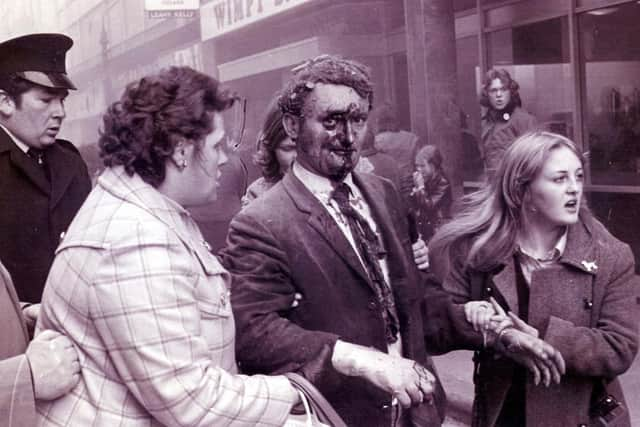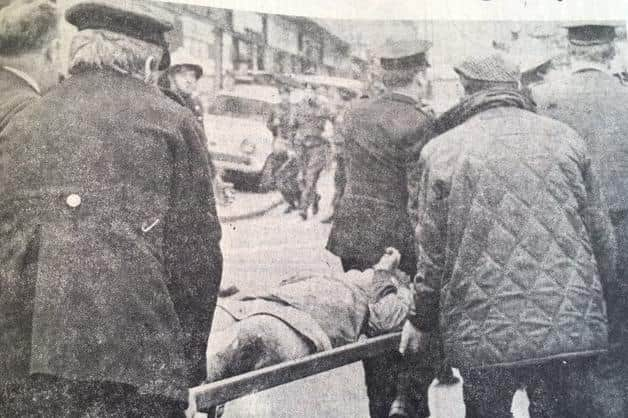Abercorn: cafe blast killed two young women and maimed others
and live on Freeview channel 276
The exceptionally cruel and indiscriminate Abercorn bombing remains a vivid memory for many of the injured and for those who witnessed the carnage 50 years ago on Friday (March 4).
Belfast’s Cornmarket area, right in the heart of the city, was packed with Saturday afternoon shoppers when a bomb left in the downstairs cafe exploded without warning.
Advertisement
Hide AdAdvertisement
Hide AdThe March 4 attack in 1972 claimed the lives of two young Catholic women and injured 130 other people.


Janet Bereen, 21 and Ann Owens, 22, were seated in the cafe when the bomb, which had been left in a bag under a table, exploded.
Several victims lost limbs and at least three lost an eye.
Janet was a radiographer at the Royal Victoria Hospital while Ann worked for the electricity board.
Such was the scale of the carnage, the RVH implemented its ‘disaster plan’ for the first time.


Advertisement
Hide AdAdvertisement
Hide AdJanet’s father was a senior anaesthetist at the RVH and had gone into work on his day off to help treat those needing emergency surgery.
As he worked to save lives in the operating theatre, he was oblivious to the fact that his own daughter had been killed in the blast.
The coroner conducting the inquest described the bombing as “pathological murder of the most depraved kind”.
A warning had been phoned to the 999 emergency operators at 4.28pm but the device exploded just two minutes later, and before police had time to react.


Advertisement
Hide AdAdvertisement
Hide AdAmong the most seriously injured to survive were sisters Jennifer McNern, 21, and Rosaleen McNern, 22, from north Belfast.
Jennifer lost both her legs while her sister lost both legs, her right arm and an eye.
Although no group has ever claimed responsibility for the bombing, unionists were quick to blame the IRA – the attack taking place at a time when both the Official IRA and the breakaway Provisionals were active.
Initial reports suggested the building had been targeted by the IRA because off-duty soldiers were frequenting the upstairs bar and cabaret rooms.
The attack was widely condemned, including by Sinn Fein.
Advertisement
Hide AdAdvertisement
Hide AdA statement from Sinn Fein said they had “consistently condemned the bombing of civilian installations” and added: “We particularly condemn the callous bombing of the Abercorn Restaurant on Saturday last, whichever group or section of the community was responsible.
“We express our regret to the relatives of those who were killed and to those who were maimed and we reiterate our belief that the Protestant community cannot be bombed into a 32 county republic.”
The following day, Northern Ireland premier Brian Faulkner said the bomb was the latest development in IRA horror, particularly the “utterly monstrous” way it was carried out.
Stormont’s community relations minister Basil McIvor said: “I was at the Abercorn shortly after the explosion took place and I have never seen a more horrible sight.
Advertisement
Hide AdAdvertisement
Hide Ad“I cannot understand how anyone, however depraved, could fail to be moved by the enormity of the injuries inflicted.”
In Dublin, the Evening Herald newspaper published a claim from the Provisional IRA that the Abercorn attack followed a warning in the loyalist UDA magazine that the premises was a “rebel stronghold”.
The same paper also carried what it said was a claim of responsibility from the Ulster Vanguard Movement.
The typed message suggested the Abercorn bomb was in retaliation for an IRA blast at an Army barracks in Aldershot, just over a week earlier, that claimed seven lives.
Advertisement
Hide AdAdvertisement
Hide AdHowever, Vanguard leader Rev Martin Smyth is also quoted in the same paper, saying: “The Vanguard does not stoop to the murder of innocent civilians.”
A News Letter report quotes Dermot O’Donnell, the owner of the upstairs cabaret club in the Abercorn, denying he had been put under pressure by loyalists because “the National Anthem was not played in the club”.
Mr O’Donnell said the national anthem wasn’t played at any similar venue, and added: “We have never received any threats.”
Addressing the congregation at St John’s Catholic Church on Belfast’s Falls Road the day after the Abercorn bomb, Canon Padraig Murphy condemned those responsible, saying that the “reckless killing that is happening daily now is always wrong” and contrary to God’s law.
Advertisement
Hide AdAdvertisement
Hide Ad“They will not make this country a better place – they will only make it worse,” the News Letter reported.
Coming just weeks after soldiers from the Parachute Regiment shot 13 people dead on Bloody Sunday, and just over a week after an IRA bomb at an Army barracks in Aldershot , the Abercorn attack was part of a spiral of violence that would make 1972 the most deadly year of the Troubles by far – with 476 people killed and many more injured.
Less than three weeks after the Abercorn attack an IRA car bomb exploded outside the News Letter’s office in Donegall Street killing seven people.
Two of those killed were police officers responding to a misleading bomb warning call, and three others were Belfast Corporation refuse collectors who were working in area.
Advertisement
Hide AdAdvertisement
Hide AdThat attack marked the beginning of a vehicle bomb campaign that would cause devastation in towns and cities across Northern Ireland, as well as several cities in Great Britain, including London.
1972 was the only year that Troubles deaths exceeded 300, although the casualty rate remained relatively high until it began to taper off from 1976 onwards.
At the Royal Victoria Hospital where the most severely injured were taken, Anne who was a Senior Nursing Officer recalled the day.
“When asked for my first recollection, I’d say the smell.
Also patients sent to theatre as soon as possible were often wearing the remains of their clothes, torn and full of dust.
Clothing removed in A&E was put in a plastic bag.
Advertisement
Hide AdAdvertisement
Hide AdExamining these was difficult: finding personal items such as pension books, car and house keys, wallets with photographs, some barely recognisable.
I remember passing a piece of jewellery to a member of admin staff to be taken to a relative for identification.”
Ms Peake concluded:
“At WAVE we are very conscious of how sensitive these anniversaries are for those most affected.
Some will want to speak out to ensure that what happened to them or their loved one is never forgotten because of the passage of time.
Others will mark it in their own quiet way.
But all will remember”.
Advertisement
Hide AdAdvertisement
Hide AdSpeaking ahead of the anniversary, a former senior nursing officer at the RVH, where the most severely injured were taken, ‘Anne,’ said she has vivid recollections of March 4, 1972.
“When asked for my first recollection, I’d say the smell,” she said.
“Also patients sent to theatre as soon as possible were often wearing the remains of their clothes, torn and full of dust.
“Clothing removed in A&E was put in a plastic bag.
“Examining these was difficult: finding personal items such as pension books, car and house keys, wallets with photographs, some barely recognisable.
Advertisement
Hide AdAdvertisement
Hide Ad“I remember passing a piece of jewellery to a member of admin staff to be taken to a relative for identification.”
WAVE CEO Sandra Peake said: “At WAVE we are very conscious of how sensitive these anniversaries are for those most affected.
“Some will want to speak out to ensure that what happened to them or their loved one is never forgotten because of the passage of time.
“Others will mark it in their own quiet way. But all will remember”.
Advertisement
Hide AdAdvertisement
Hide AdREAD: Abercorn: wedding dress search ended in tragedy for inseparable sisters
——— ———
A message from the Editor:
Thank you for reading this story on our website. While I have your attention, I also have an important request to make of you.
With the coronavirus lockdowns having had a major impact on many of our advertisers — and consequently the revenue we receive — we are more reliant than ever on you taking out a digital subscription.
Subscribe to newsletter.co.uk and enjoy unlimited access to the best Northern Ireland and UK news and information online and on our app. With a digital subscription, you can read more than 5 articles, see fewer ads, enjoy faster load times, and get access to exclusive newsletters and content.
Advertisement
Hide AdAdvertisement
Hide AdVisit https://www.newsletter.co.uk/subscriptionsnow to sign up.
Our journalism costs money and we rely on advertising, print and digital revenues to help to support them. By supporting us, we are able to support you in providing trusted, fact-checked content for this website.
Ben Lowry, Editor